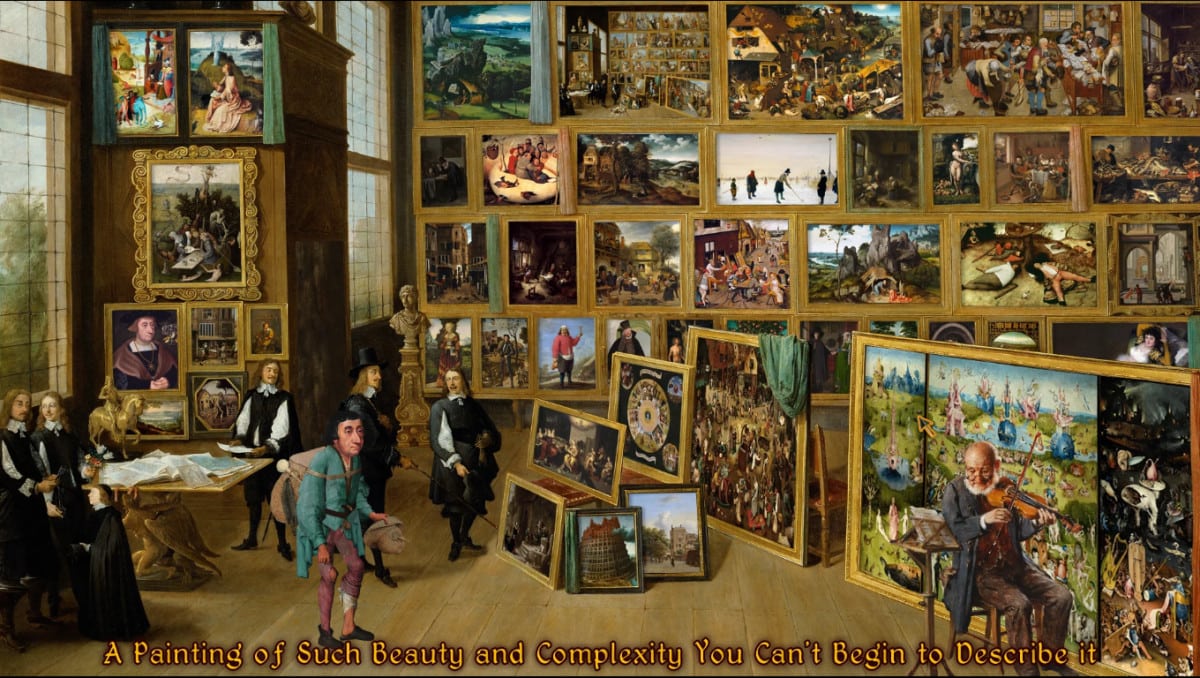

Indie game developer Joe Richardson released The Procession to Calvary on 9 April 2020: a point-and-click adventure game and a zany, murderous rampage through Terry Gilliam-inspired cut-up animations of the Old Masters.
Since the game is so far available only on Steam (but reportedly coming to iOS in the not so distant future), we decided to revisit its spiritual predecessor, Four Last Things (2017) and the Hieronymous Bosch painting that inspired it. Roving through a mash-up of the Dutch Renaissance, the key to winning is sinning.
Roving through a mash-up of the Dutch Renaissance, the key to winning is sinning
For hundreds of years, religion shaped Western art; yet when contemporary artists tackle Christian subjects, more often than not their works are iconoclastic and subversive. Take Andres Serrano’s ‘Piss Christ’ (1987), which submerges a tiny plastic crucifix in a glass of urine. Or Chris Ofili’s ‘The Holy Virgin Mary’ (1996), a black Madonna with a bare breast shaped from elephant dung.
As irreverent as these works are, it’s difficult to shake millennia of superstitious thinking. Whether you believe in art’s economic, aesthetic, or societal value, it’s belief that keeps the wheels turning. The gallery is the church, the artist the saint, the curator the priest, the artwork the relic.

Not so for indie game developer Joe Richardson; art history is his raw material. Richardson’s Four Last Things — a ridiculous point-and-click adventure game made from Renaissance-era paintings and public domain recordings of classical music — is both homage and beeldenstorm.
Borrowing the cut-out animation style and ludic humour from Monty Python, Four Last Things is a romp through works from Jan van Eyck to Hieronymous Bosch.
Off you go into a distorted, cess-pool version of 16th century Flanders, pointing and clicking
You play as a peasant-cum-hobo, who has committed all seven deadly sins, and is now on a quest for redemption. But there’s a problem, as some bishops inform you — a Kafkaesque clerical error. Since you’ve been sinning everywhere from Oslo to Nuremberg, your sins fall outside the clergy’s catchment area.
Your mission, therefore, is to commit all seven sins again, inside the jurisdiction of the local parish, so that the clergy can officially absolve you. Off you go into a distorted, cess-pool version of 16th century Flanders, pointing and clicking, solving puzzles in order to behave deplorably.
ArrayThe game is inspired by The Seven Deadly Sins and the Four Last Things (around 1500), attributed to Bosch or to a follower of his. Painted on a tabletop (which was destined to furnish a bedroom in King Philip’s Escorial palace) it’s a real Lazy Susan of a masterpiece. Practically begging to be given a spin is a large circle divided into seven sections, each depicting one of the deadlies.
At the centre of this circle is a ‘pupil’, believed to represent the eye of God, and inside the pupil Christ is emerging from his tomb. Psychedelic stuff. Four outer discs depict the Four Last Things — Death, Judgment, Heaven and Hell — according to Christian eschatology.
Created for a table top, it was designed for a specific type of interaction; spiritual contemplation, for sure
Creating a game from this painting is 1) very funny, and 2) interesting to consider as a critical gesture (though I don’t think it’s intended to be); it invites a focus on the source paintings as playful or game-like in and of themselves.
The Seven Deadly Sins looks a lot like some bizarro Trivial Pursuit board. Created for a table top, it was designed for a specific type of interaction; spiritual contemplation, for sure, but at the same time, a more casual and functional purpose. Its vignettes are also highly entertaining — see the spooky, Ghost Train demons popping out from behind curtains and wardrobes, or the poor guy boiling in a pot of gold in hell.

In light of Joe Richardson’s game, I can’t help but read the Bosch painting as an attempt to gamify morality. Remember, it seems to say, if you score enough good points with God, you’ll be going to heaven; be careful of landing on these seven tiles, though, or you’ll be heading downstairs. Do not pass go.


